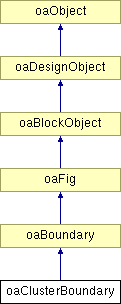 |
 |
 |
||||||
Inheritance diagram for oaClusterBoundary:

 |
 |
Public Methods | |
| oaCluster * | getCluster () const |
| void | getName (oaString &name) const |
| void | setName (const oaString &name) |
Static Public Methods | |
| oaClusterBoundary * | create (oaCluster *cluster, const oaString &name, const oaPointArray &points, const oaString *edgeNames=NULL) |
| oaClusterBoundary * | create (oaCluster *cluster, const oaPointArray &points, const oaString *edgeNames=NULL) |
| oaClusterBoundary * | find (const oaCluster *cluster, const oaString &name) |
| oaClusterBoundary * | create (oaCluster *cluster, const oaString &name, const oaPointArray &points, const oaStringArray &edgeNames) |
| oaClusterBoundary * | create (oaCluster *cluster, const oaPointArray &points, const oaStringArray &edgeNames) |
|
||||||||||||||||
|
This function creates a new cluster boundary object in the specified cluster with the specified attributes. A name for the new cluster boundary is automatically generated, with the default name prefix B__%d, d referring to a unique integer. Note that the number of edge names must be equal to the number of points or an oacBoundaryInvalidEdgeNames exception is thrown. If the boundary edgeNames array is empty, the edges are automatically named using the form EDGE_n, where n starts at zero and increments by one. Note: The order of the points actually set on the oaClusterBoundary is not guaranteed to be the same as the order of points passed to the create() function. Consequently, the order of points returned by a subsequent oaClusterBoundary::getPoints() may be different from the order of points specified in points.
|
|
||||||||||||||||||||
|
This function creates a new cluster boundary object in the specified cluster with the specified attributes. Note that the number of edge names must be equal to the number of points or an oacBoundaryInvalidEdgeNames exception is thrown. If the boundary edgeNames array is empty, the edges are automatically named using the form EDGE_n, where n starts at zero and increments by one. Note: The order of the points actually set on the oaClusterBoundary is not guaranteed to be the same as the order of points passed to the create() function. Consequently, the order of points returned by a subsequent oaClusterBoundary::getPoints() may be different from the order of points specified in points.
|
|
||||||||||||||||
|
This function is deprecated. Refer to the create function that takes a reference to an oaStringArray for edgeNames. This function creates a new cluster boundary object in the specified cluster with the specified attributes. A name for the new cluster boundary is automatically generated, with the default name prefix B__%d, d referring to a unique integer. Note that the number of edge names is assumed to be equal to the number of points. If boundary edgeNames are not supplied, the edges are automatically named, using the form EDGE_n, where n starts at zero and increments by one. Note: The order of the points actually set on the oaClusterBoundary is not guaranteed to be the same as the order of points passed to the create() function. Consequently, the order of points returned by a subsequent oaClusterBoundary::getPoints() may be different from the order of points specified in points.
|
|
||||||||||||||||||||
|
This function is deprecated. Refer to the create function that takes a reference to an oaStringArray for edgeNames. This function creates a new cluster boundary object in the specified cluster with the specified attributes. Note that the number of edge names is assumed to be equal to the number of points. If boundary edgeNames are not supplied, the edges are automatically named, using the form EDGE_n, where n starts at zero and increments by one. Note: The order of the points actually set on the oaClusterBoundary is not guaranteed to be the same as the order of points passed to the create() function. Consequently, the order of points returned by a subsequent oaClusterBoundary::getPoints() may be different from the order of points specified in points.
|
|
||||||||||||
|
This function searches the design of the specified cluster for a cluster boundary with the specified name. The boundary is returned if found. Otherwise, NULL is returned. |
|
|
This function returns the cluster of this boundary. |
|
|
This function fills in name with the name of this boundary. |
|
|
This function sets the name of this cluster boundary to the specified name.
|

Copyright © 2002 - 2010 Cadence Design Systems, Inc.
All Rights Reserved.